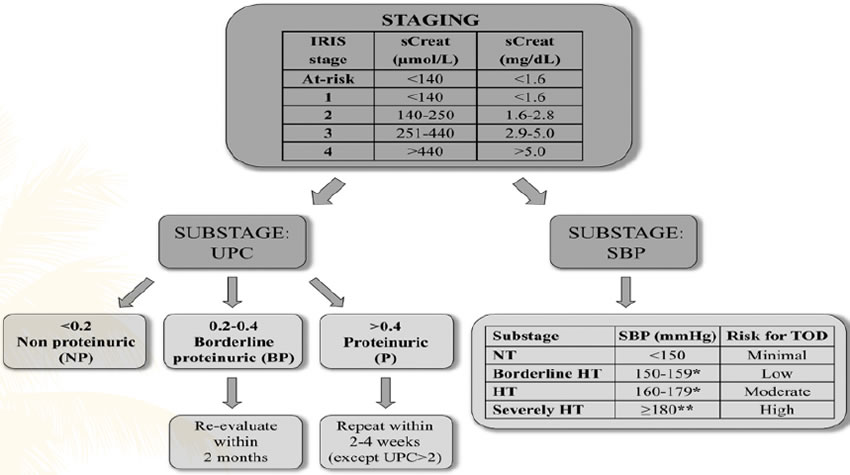Small Animal Department, Faculty of Veterinary Medicine, Ghent University, Merelbeke, Belgium
A classification system to stage dogs and cats with chronic kidney disease (CKD) has been developed by the International Renal Interest Society (IRIS) and accepted by American and European Societies of Veterinary Nephrology and Urology, in analogy to the situation in human medicine. Staging should be undertaken following the diagnosis of CKD. The main goals of staging are to facilitate treatment and monitoring of patients with CKD by providing specific therapeutic recommendations adapted for each disease stage, and to assist in estimating the prognosis of CKD patients. Further, the IRIS staging facilitates communication in scientific literature and amongst veterinarians by standardizing and simplifying nomenclature.1,2
In human medicine, five CKD stages were developed according to the level of glomerular filtration rate of the patient, mostly estimated using creatinine-based equations.3 In veterinary medicine, the CKD stage is based on serum creatinine concentration, assessed on at least two occasions, and further substaging is based on proteinuria, assessed by the urinary protein:creatinine ratio (UPC), and systolic blood pressure (SBP) (Figure 1). Four CKD stages and one at-risk group can be identified based on clinical information and serum creatinine concentration. Only stable patients can be staged (i.e., well-hydrated, normal eating/drinking behavior), preferably after 12-hour fasting with free access to water. Prerenal or postrenal azotemia needs to be corrected prior to staging to prevent allocating cats incorrectly to a higher disease stage and worsened prognosis.1,4 For proteinuria substaging, only persistent renal proteinuria is of importance. A stepwise diagnostic approach must be followed to eliminate prerenal and postrenal proteinuria. Persistence of proteinuria should be evaluated based on at least two urine samples collected over a period of at least 2 weeks.1,5 The SBP substaging system reflects the risk that end-organ injury arises in the eyes, brain, kidneys or heart.
Efforts must be taken to minimize white-coat hypertension and SBP must be preferably based on multiple measurements during repeated consultations over several weeks.1,6 At each follow-up consultation, the stage and substages assigned to a patient should be revised where needed.1
Recently, the IRIS Board has proposed some modifications to their guidelines based on blood concentrations of symmetric dimethylarginine (SDMA). SDMA is a promising new diagnostic marker of renal function that has two important advantages over serum creatinine. Firstly, SDMA increases earlier in the disease process than serum creatinine and persistent increases of SDMA above the reference interval (14 µg/dL) indicate kidney dysfunction.7 The IRIS recommends to consider these cats as CKD IRIS stage 1.1 Secondly, SDMA concentrations are not related to muscle mass.8 In cats with CKD that present with low body condition scores or muscle atrophy, SDMA might more correctly estimate the severity of renal dysfunction, leading to more appropriate therapeutic measurements.1
| Figure 1. Overview of the International Renal Interest Society (IRIS) staging for feline patients with chronic kidney disease | 
* Persistence of elevation should be judged on multiple blood pressure measurements over a period of 1 to 2 months.
** Persistence of elevation should be judged on multiple blood pressure measurements over a period of 1 to 2 weeks.
Abbreviations: HT = Hypertensive; IRIS = International Renal Interest Society; NT = Normotensive; SBP = Systolic blood pressure; sCreat = Serum creatinine concentration; TOD = Target organ damage; UPC = Urinary protein: creatinine ratio.
(Based on the website of IRIS)1
|
|
| |
Survival rates for CKD are significantly associated with azotemia (and thus IRIS stage) and proteinuria, meaning that cats diagnosed early in the disease live longer than cats with more severe azotemia.4,9 Moreover, the prevalence of CKD-associated complications rises with advanced stage.2 Consequently, a better prognosis can be expected for cats diagnosed in the non-azotemic disease stage (IRIS stage 1 and early 2) because timely therapeutic intervention might prevent or delay disease progression and complications. Although early disease detection might be challenging, veterinarians are strongly encouraged to screen cat populations at risk for CKD in order to improve the recognition of these early stages of CKD.
References
1. International Renal Interest Society (IRIS). IRIS staging of CKD (modified 2015). Available from: www.iris-kidney.com/pdf/003-5559.001-iris-website-staging-of-ckd-pdf_220116-final.pdf (VIN editor: the link was modified on 10-10-2017).
2. Polzin DJ. Chronic kidney disease. In: Ettinger SJ, Feldman EC, editors. Textbook of Veterinary Internal Medicine. 7th ed. St-Louis, MO, USA: Elsevier Saunders;2010:1990–2021.
3. National Kidney Foundation (NKF). K/DOQI clinical practice guidelines for chronic kidney disease: evaluation, classification and stratification. Am J Kidney Dis. 2002;39(2 Suppl 1):S1–S266.
4. Boyd LM, Langston C, Thompson K, et al. Survival in cats with naturally occurring chronic kidney disease (2000–2002). J Vet Intern Med. 2008;22:1111–1117.
5. Lees GE, Brown SA, Elliott J, et al. Assessment and management of proteinuria in dogs and cats: 2004 ACVIM forum consensus statement (small animal). J Vet Intern Med. 2005;19:377–385.
6. Brown S, Atkins C, Bagley R, et al. Guidelines for the identification, evaluation, and management of systemic hypertension in dogs and cats. J Vet Intern Med. 2007;21:542–558.
7. Hall JA, Yerramilli M, Obare E, et al. Comparison of serum concentrations of symmetric dimethylarginine and creatinine as kidney function biomarkers in cats with chronic kidney disease. J Vet Intern Med. 2014;28:1676–1683.
8. Hall JA, Yerramilli M, Obare E, et al. Comparison of serum concentrations of symmetric dimethylarginine and creatinine as kidney function biomarkers in healthy geriatric cats fed reduced protein foods enriched with fish oil, L-carnitine and medium-chain triglycerides. Vet J. 2014;202:588–596.
9. Syme HM, Markwell PJ, Pfeiffer D, Elliott J. Survival of cats with naturally occurring chronic renal failure is related to severity of proteinuria. J Vet Intern Med. 2006;20:528–535.